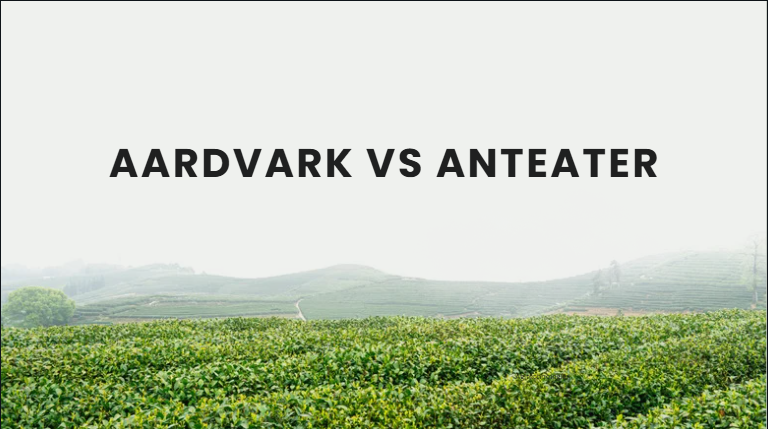When people hear the words aardvark and anteater, they often think these two animals are the same. Both eat ants, have long tongues, and look a bit similar. But in truth, they are very different creatures that live in different parts of the world and belong to different animal families. This article will explain the main differences between aardvarks and anteaters in easy and simple words.
1. Introduction to Aardvarks and Anteaters
The aardvark is a mammal found in Africa, while the anteater lives in Central and South America. Both are insect-eating animals, known as myrmecophages (which means “ant eaters”). But even though they share this diet, they are not closely related.
Aardvarks belong to a group of animals called Tubulidentata, while anteaters are part of a group called Pilosa, which also includes sloths. Their similar looks are a result of convergent evolution, meaning they evolved similar features to survive in similar ways.
2. Physical Appearance
Aardvark Appearance
Aardvarks have a pig-like nose, long ears, and a strong, thick tail. They are usually about 4 feet long, not counting their tail, and can weigh up to 65 kilograms. Their body is covered with rough, brownish-gray skin that protects them from ant bites and the hot African sun.
Anteater Appearance
Anteaters come in different sizes. The largest, called the giant anteater, can grow up to 7 feet long including the tail. They have a long, narrow snout, small eyes, and a bushy tail that helps them stay warm. Their fur is long and soft, with black and white markings along the body.
3. Habitat and Location
Where Aardvarks Live
Aardvarks live all across sub-Saharan Africa. They like grasslands, savannas, and woodlands, but they avoid very dry deserts and very wet forests. They dig burrows where they rest during the day and come out at night to search for food.
Where Anteaters Live
Anteaters live in Central and South America, from Mexico to Argentina. They can be found in rainforests, grasslands, and savannas. Unlike aardvarks, some anteaters, like the tamandua, can climb trees to find ants and termites.
4. Diet and Feeding Habits
Both aardvarks and anteaters mainly eat ants and termites, but they do it in different ways.
How Aardvarks Eat
Aardvarks use their strong claws to open termite mounds and ant nests. They then use their long, sticky tongue to collect insects quickly. An aardvark’s tongue can reach up to 30 centimeters long! They also have a keen sense of smell to find insects underground.
How Anteaters Eat
Anteaters have no teeth, just like aardvarks, but their tongues are even longer — up to 60 centimeters in the giant anteater. They flick their tongues in and out around 150 times per minute to grab ants and termites. They also use their strong forelimbs and sharp claws to tear open insect nests.
5. Behavior and Lifestyle
Aardvark Behavior
Aardvarks are nocturnal, which means they come out only at night. They spend the day sleeping in their cool burrows. They are solitary animals, meaning they prefer to live alone. Their burrows are large and can be up to 10 meters long, offering safety from predators like lions and hyenas.
Anteater Behavior
Anteaters can be diurnal (active during the day) or nocturnal, depending on the species. The giant anteater lives mostly on the ground, while smaller ones, like the silky anteater, live in trees. Anteaters are also solitary, and they walk slowly but can run or defend themselves using their sharp claws if attacked.
6. Reproduction and Lifespan
Aardvark Life
Female aardvarks give birth to one baby at a time, usually after a pregnancy of about 7 months. The baby stays in the burrow for the first few weeks and then follows its mother while learning to dig and find food. Aardvarks can live up to 20 years in the wild.
Anteater Life
Female anteaters also give birth to one baby at a time. The baby rides on its mother’s back for several months until it is strong enough to walk and search for food. Anteaters live around 14 to 16 years in the wild.
7. Key Differences at a Glance
FeatureAardvarkAnteaterLocationAfricaCentral & South AmericaFamily GroupTubulidentataPilosaTeethHas small tube-like teethNo teethHabitatGrasslands, savannasRainforests, grasslandsActivity TimeNocturnalDay or night, species dependentTail TypeThick and strongLong and furryTongue LengthAbout 30 cmUp to 60 cm
8. Importance in Nature
Both aardvarks and anteaters play an important role in nature. They help control insect populations, which protects plants and keeps ecosystems balanced. Their digging also helps aerate the soil, making it healthy for other plants and animals.
9. Fun Facts
- The word “aardvark” means “earth pig” in Afrikaans.
- The giant anteater can eat up to 30,000 ants and termites in one day.
- Aardvarks are related to elephants and manatees, not anteaters!
- Anteaters use their tail as a blanket to keep warm while sleeping.
10. Conclusion
While the aardvark vs anteater may look and act alike, they are very different animals from different parts of the world. The aardvark belongs to Africa, while the anteater comes from the Americas. Both have unique ways to survive and play vital roles in their environments. Understanding these differences helps us appreciate how nature creates amazing creatures that adapt in their own ways.
FAQs
Q1: Are aardvarks and anteaters related?
No, they are not related. They only look similar because they both eat ants and termites.
Q2: Do aardvarks and anteaters live in the same place?
No. Aardvarks live in Africa, while anteaters live in Central and South America.
Q3: Do aardvarks have teeth?
Yes, aardvarks have small, tube-shaped teeth. Anteaters have no teeth at all.
Q4: Which animal is bigger — the aardvark or the anteater?
The giant anteater is bigger than an aardvark.
Q5: Can aardvarks or anteaters be kept as pets?
No, both animals are wild and need special diets and natural habitats to live healthily.


